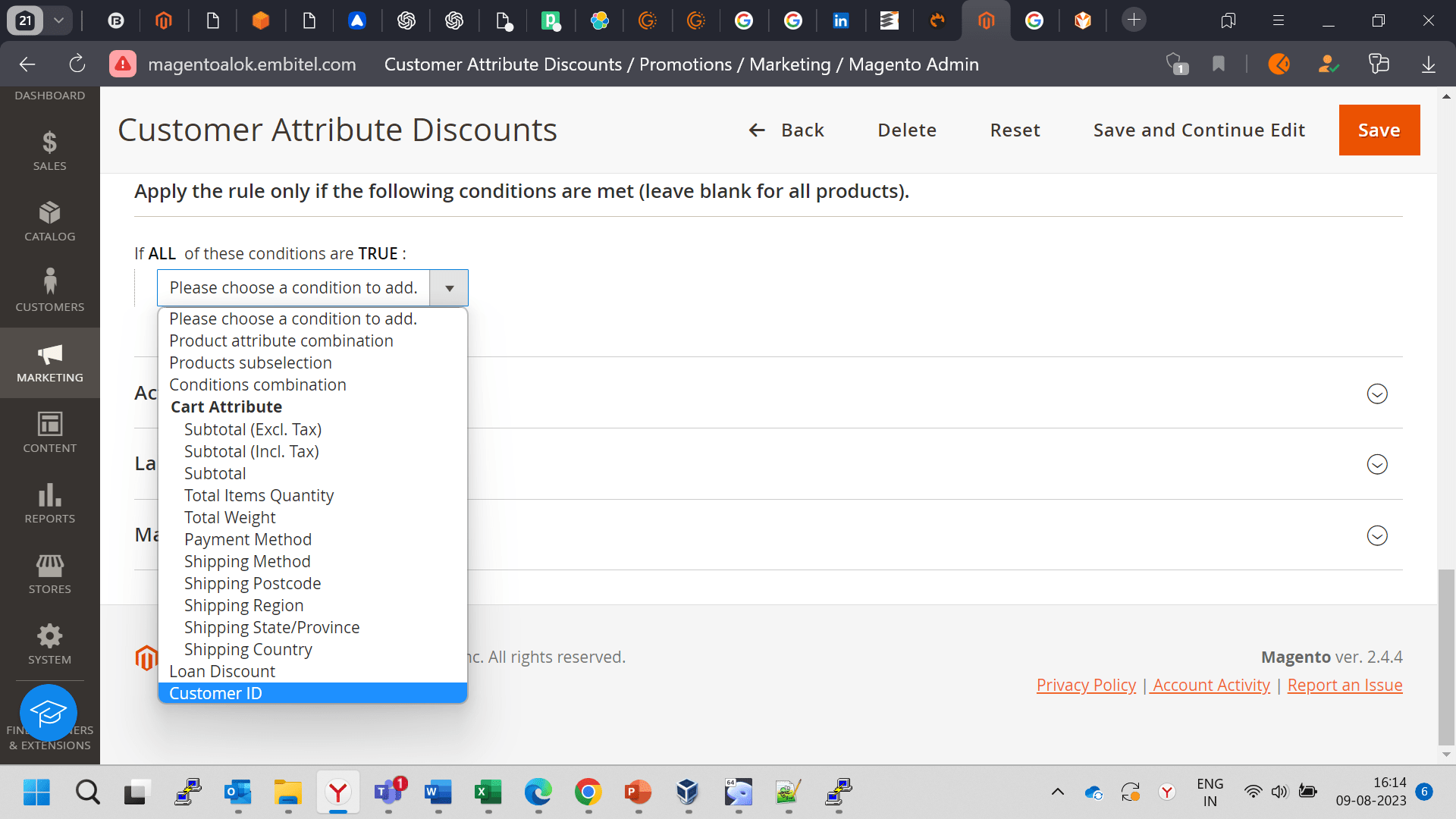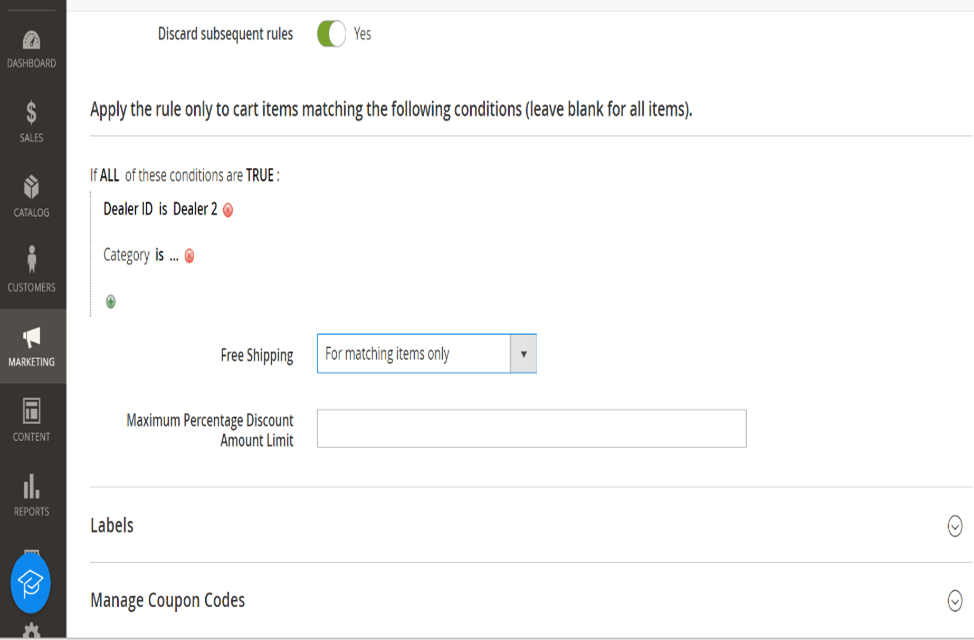As an e-commerce brand, enhancing conversion rates and customer retention while reducing cart abandonment are your life goals. The sure shot way to achieve these long-term goals is to be able to deliver a consistent and personalized experience to your shoppers across your e-commerce website and mobile app!
 Personalized and relevant pricing and promotional marketing strategies play a strong role in elevating the customer experience quotient. This, effectively, increases customer retention and drives more sales.
Personalized and relevant pricing and promotional marketing strategies play a strong role in elevating the customer experience quotient. This, effectively, increases customer retention and drives more sales.
Magento 2 e-commerce platform offers you a plethora of options to create multiple promotional pricing rules, that align with your customers’ needs and interests.
With Magento 2, you can offer products at discounted prices to your customers based on a set of defined conditions. This provides a highly flexible solution to enhance your shopper’s online experience.
How Magento 2 Catalog Price Rules are a Game-changer for E-commerce Brands
As per Statista, about 93% of Shoppers in the US use a coupon or discount code throughout the year.
54% of shoppers, in a survey specified that they will purchase products left in shopping carts, if offered a discount.
More than 70% of online shoppers in US say that discounts have the biggest effect on purchase decisions during the holidays.
So, what does that mean?
Everyone likes a good deal and if you are able to delight your customer with a relevant promo you got a loyal customer!
Satisfied customers are more likely to leave positive reviews, recommend your store to others, and become brand advocates.
In this article, we will give you an overview of some best practices for creating effective dynamic and custom cart pricing and promotional rules using Magento 2 e-commerce platform. We will touch upon some
How Do I Create a Price Rule in Magento 2?
Here is a quick step-by-step guide on setting up Magento 2 catalog price rules for your e-commerce website via the admin panel:
| a. Login to Magento 2 Admin Dashboard | Log in to your Magento 2 Admin Dashboard with your credentials. |
| b. Navigate to Promotions | Go to “Marketing” in the main menu and click on “Promotions.” |
| c. Create a New Cart Price Rule |
Click on “Cart Price Rules” in the sub-menu.
Click the “Add New Rule” button to create a new rule. |
| d. Set the Pricing Rule |
Enter a unique Rule Name to identify the promotion.
Set the Rule Status to “Active.” Select the Customer Groups to whom the promotion applies (e.g., All Customers, Not Logged In, etc.). |
| e. Set Conditional Pricing Rule |
You can set conditions for the promotion, such as specific products, categories, or order amounts, to trigger the discount. |
| f. Define Actions |
Once you have set the required pricing and custom conditions, go to the “Actions” tab.
Now choose the type of discount you want to offer (e.g., Percentage of product price discount, Fixed amount discount, etc.). Set the Discount Amount and any other necessary parameters. |
What are the Different Types of Cart & Catalog Pricing Rules I Can Implement on Magento2?
Now going back to the steps e) and f) in the above table, let’s discuss the different custom pricing and promotional rules programs that you can specify and generate using Magento 2:
- Custom Customer Attributes/ Cart Price Rules
- Catalog Price Rule in Magento 2
- Promos Allowing Cross Platform Onboarding / API-based Customer-Specific Coupon
- Cross-Platform Discounts: Admins can offer one-time discounts using coupon codes to customers from a different onboarding platform when they purchase from the e-commerce platform.
- CRM Auto-generates Coupon Codes: When a new customer is onboarded on the CRM system, the CRM automatically generates a unique coupon code “per customer.”
- REST API Provisioning: The CRM then populates these one-time-use coupon codes into Magento using a REST API. This ensures seamless integration and hassle-free coupon provisioning.
- Validation and Category Selection: Customers are validated based on whether they belong to the “Loan Discount” scheme, making them eligible for the specific coupon. Additionally, customers can choose a specific category on which they can avail the discounts.
- Backend Management: Each coupon code is unique to the customer and is stored in a separate table. There is no need to define multiple one-time-use coupons via the frontend, as the API request automatically generates and stores them in the backend.
- Cart Price Rule Validator: The Cart Price Rule validator ensures that each “customer-specific coupon” can only be used once, preventing misuse and enhancing security.
- Chosen Seller/Dealer-Based Discount Rules
- Lightning Deals
- Payment or Product Category specific Discount
So, What are cart price rules on Magento 2? The Cart Price Rule is a versatile feature that allows e-commerce store admins to create special pricing rules for their customers.
By defining specific conditions in the configuration, store admins can offer discounts on certain products or entire orders through coupon codes.
Cart Price Rules are a default feature available with Magento 2, but they contain a very limited set of default attributes/standard conditions that can be used. However, there is a workaround to extend the attributes based on which you can add endless customizations to your pricing rules.
All you have to do is select the “Custom Customer Attributes” option and specify the custom pricing rules based on your business requirement.
This feature allows store admins to set pricing rules and coupons based on key customer attributes like Customer ID. This enables them to offer personalized discounts to specific customers or groups based on their preferences or past interactions.
For instance, admins can extend discounts to customers who had a bad prior delivery experience, creating a highly granular and targeted approach to enhance customer satisfaction.

With the flexibility to define specific coupons and rules per customer or customer attributes, Magento 2’s Cart Price Rule ensures a delightful shopping experience for customers, increasing loyalty and driving repeat business.
The feature empowers admins to tailor promotions, build stronger customer relationships and ultimately boost sales performance.
Catalog Price Rule: A catalogue price rule in Magento 2 enables you to offer products at discounted prices to your customers based on set of conditions – that can be applied to selected or all products base don your requirements. The key differentiator of catalogue price rule in Magento 2 is that you can trigger discount on selected products programmatically without the customer having to use any discount coupon code.
What is difference between Cart price Rule and Catalog price Rule in Magento 2?
Purpose: Catalog Price Rules in Magento 2, are applied at the product level and affect the displayed product prices in the catalog.
Application: These rules are used to set discounts on products based on specific conditions, such as product attributes, categories, customer groups, or time periods.
Effect: When you implement Catalog Price Rule in Magento 2, customers will see discounted prices when browsing the product catalog. The actual discounted price is displayed, encouraging customers to make a purchase.
Cart Price Rule:
Purpose: Cart Price Rules are applied during the checkout process and affect the total order amount in the shopping cart.
Application: These rules are used to set discounts on the entire cart based on various conditions, such as order total, shipping address, payment method, or coupon codes.
Effect: When a Cart Price Rule is applied, customers can avail discounts on their entire order during checkout by entering a valid coupon code or meeting the specified conditions.
In summary, Catalog Price Rules apply discounts to individual products in the catalog, affecting the displayed prices, while Cart Price Rules apply discounts to the entire cart during checkout, affecting the final order amount. Both types of rules are valuable tools for e-commerce store owners to offer enticing discounts and enhance the overall shopping experience for their customers.
The API-based Customer Specific Coupon Generation in Magento 2 enables e-commerce store admins to offer personalized discounts to customers based on their onboarding platform. Here are the steps to implement this feature:
This Customer-Specific Cart Price Rule in Magento 2 creates a seamless and personalized shopping experience for customers. This feature streamlines the coupon generation process, eliminating the need for manual front-end entries, and smoothens overall shopping experience.
Additionally, this pricing rule also offers you a chance to upsell and cross-sell your e-commerce product offerings to your new/existing customers.

With this price rule, admins of e-commerce store on Magento 2 can create personalized discount coupons for customers purchasing from selected dealers or sellers. It allows admins to set specific Cart Price Rules and Coupons that are applicable only to a particular Dealer ID or based on multiple conditions like categories or attributes mapped to specific Dealer IDs.
Customers can avail these exclusive coupons only if the items they choose belong to the designated Dealer ID or meet the predefined conditions. With the flexibility to configure various combinations of conditions and cart item actions, the feature caters to the unique needs of each dealer and their target customers.
It ensures that discounts apply only to items belonging to the specific dealer in multi-item cart checkout scenarios, ensuring fairness and accuracy in discount allocation.
This feature serves as a powerful tool for dealers who want to distribute discount coupons to potential buyers through the online platform. It creates a win-win situation for e-commerce retailers and shoppers alike.
Store admins can effectively manage pricing rules and tailor discounts to specific dealers, driving business growth and customer retention. On the other hand, shoppers enjoy personalized offers, making their shopping experience more enjoyable and liable to repeat purchases.
As the name suggests, Lightning Deals as a pricing rule in Magento 2 empowers e-commerce store admins to offer limited-time discounts on select products.
Admins can configure the start date and duration of the Lightning Deals, making them available for a short period.
A new validator is added to ensure that the deal type is indeed Lightning, and that the deal is still valid at the time of checkout. This guarantees that shoppers can avail of the time-sensitive discounts, adding value to their purchases and incentivizing them to complete their transactions promptly.
 These deals act as cart price rules that are only valid for a limited time, creating a sense of urgency and encouraging shoppers to make quick purchase decisions.
These deals act as cart price rules that are only valid for a limited time, creating a sense of urgency and encouraging shoppers to make quick purchase decisions.
This promotional strategy is quite common, especially during holiday season /festival-specific sales to boost sales.
Sometimes, stores can offer an exciting feature to provide discounts or EMI schemes to e-commerce customers based on selected payment methods. These special offerings are made available through certain Cards and Payment Mechanisms, as provided by the Payment Gateway Provider.
The availability of EMIs, schemes, and PG-specific discounts is dependent on the product category and its price.
To ensure a hassle-free experience for shoppers, the store can integrate with Payment Provider APIs, Javascript SDKs, and libraries. This integration allows the admin to display the available EMI options for a specific product directly on the Product Display Page (PDP).
Moreover, an “admin control” feature can be provided that empowers the store owner to disable specific schemes from being visible on the PDP page, if necessary. It gives the store full control over which offerings are presented to their customers.
It’s important to note that these schemes, though offered via the Payment Gateway, can be viewed by the customer while selecting the product on the PDP page, rather than during the checkout or payment process.
This way, customers can easily see and take advantage of the available discounts and EMI options while making their product choices. It enhances transparency and encourages customers to make informed purchase decisions, boosting their overall shopping experience.
Conclusion
So, we have discussed how a strategically defined and well-placed pricing and promotional rule is a game-changer for the retailer as well as the shopper.
If you are keen to leverage and implement such strategic and custom pricing rules to revive sales and boost your customer experience quotient, get in touch with our team ( drop a mail sales@embitel.com)
Alok is our Chief Architect with Digital Commerce Business Unit. A curious, rational, analytical, and methodical individual, Alok brings an incredible passion for developing and delivering innovative industry-focused solutions.
Beyond technology, he is a fervent explorer, always seeking new avenues of knowledge. Alok’s passions extend to trekking, hiking, backpacking, and embarking on thrilling long drives.




